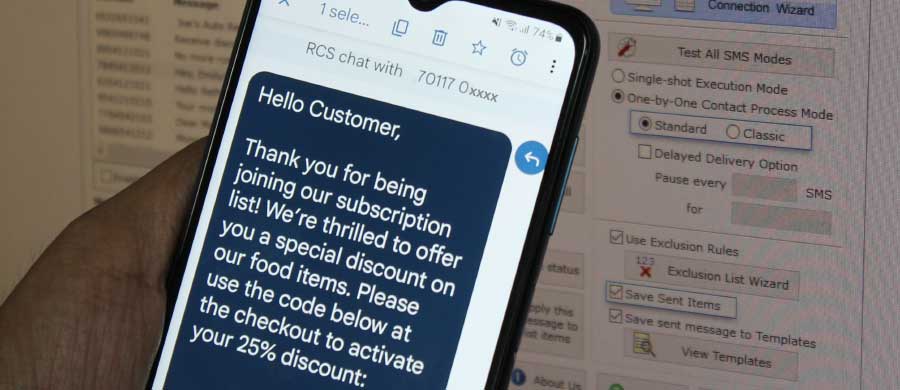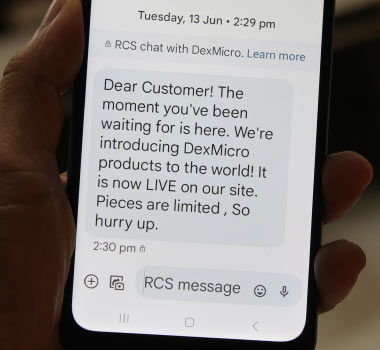Bulk SMS Software
Bulk SMS software refers to a computer-based application or platform that enables businesses and individuals to send large volumes of text messages to multiple recipients simultaneously. It is designed to simplify and streamline the process of sending SMS (Short Message Service) messages in bulk, allowing for efficient communication with a large audience.
Bulk SMS software typically offers a user-friendly interface that allows users to compose and send messages, manage contact lists, track delivery statuses, and analyze campaign performance. It may be a standalone software installed on a computer or a web-based service accessed through a browser.

-
Message Composition: The software provides a text editor or template builder that allows users to create personalized messages. It may support various formatting options, including adding dynamic content such as recipient names or other variables.
-
Contact Management: Bulk SMS software enables users to import and manage contact lists. This can involve uploading contacts from various file formats, creating groups or segments for targeted messaging, and storing additional information such as names and phone numbers.
-
Message Scheduling: Users can set specific dates and times for messages to be sent, ensuring timely delivery and avoiding inconveniencing recipients with late-night or early-morning messages.
-
Sender ID Customization: The software may allow users to customize the sender ID displayed on the recipient's phone. This can be a company name or a dedicated shortcode, making it easier for recipients to identify the sender.
-
Delivery Tracking: Bulk SMS software often provides delivery tracking features to monitor the status of messages. It enables users to view delivery reports and receive notifications regarding successful or failed deliveries.
-
Opt-Out Management: To comply with regulations and maintain subscriber preferences, the software may offer opt-out management features. This allows recipients to unsubscribe from receiving further messages, and the software automatically updates the opt-out list accordingly.
-
Analytics and Reporting: Advanced bulk SMS software includes analytics and reporting tools to track the performance of SMS campaigns. Users can access data such as delivery rates, click-through rates, conversion rates, and other metrics to evaluate the effectiveness of their messaging efforts.
-
Integration Capabilities: Bulk SMS software can integrate with other systems and applications such as CRM (Customer Relationship Management) software or marketing automation tools. This enables seamless data synchronization, automation of messaging workflows, and improved overall efficiency.
-
Security and Compliance: Good bulk SMS software prioritizes data security and compliance with privacy regulations. It ensures that sensitive information is protected, offers encryption options, and adheres to industry-standard security practices.
Businesses utilize bulk SMS software for a range of purposes, including marketing campaigns, transactional notifications, customer support, appointment reminders, event invitations, and internal communications. By leveraging this software, organizations can reach a large number of recipients instantly, enhance customer engagement, improve operational efficiency, and achieve their communication goals effectively.
Level of Support Provided for Bulk SMS Service
The level of support provided for bulk SMS services can vary depending on the SMS service provider you choose. However, reputable providers typically offer various levels of support to assist their customers throughout the integration and usage process. Here are the different levels of support commonly available:
-
Documentation and Knowledge Base:
SMS service providers typically provide detailed documentation and knowledge bases that contain comprehensive information about their services, features, API integration, and best practices. These resources can help you understand the functionalities, configuration options, and technical details of the service. They often include code examples, tutorials, FAQs, and troubleshooting guides to assist you in implementing and troubleshooting your integration.
-
Developer Support:
Most SMS service providers offer developer support to assist with technical queries related to API integration, code implementation, and troubleshooting. You can reach out to their support team via email, support tickets, or developer forums to get guidance on specific issues or challenges you may encounter during the integration process. Developer support is particularly useful when you require assistance with API endpoints, request/response formats, authentication, and error handling.
-
Account Manager or Customer Success Representative:
Some SMS service providers assign an account manager or customer success representative to their customers. This person serves as a dedicated point of contact and can provide personalized assistance, guidance, and recommendations based on your specific requirements and usage patterns. They can help you optimize your SMS campaigns, suggest best practices, and provide insights into maximizing the effectiveness of your messaging strategies.
-
Service Level Agreements (SLAs):
In some cases, SMS service providers offer Service Level Agreements (SLAs) that define the level of support and response times they guarantee to their customers. SLAs outline the expected uptime, performance, and availability of the service, as well as the support response and resolution times for different types of issues. SLAs provide you with assurance regarding the reliability and support you can expect from the SMS service provider.
-
Live Chat or Phone Support:
Certain SMS service providers offer live chat or phone support to help you resolve urgent issues or get immediate assistance. This type of support is particularly valuable when you encounter critical problems during the integration process or when you require real-time troubleshooting. It allows you to have direct communication with support representatives who can guide you through the resolution process.
Conclusion: It's important to review the support options and terms offered by different providers before selecting one. Consider factors such as the level of support you require, the responsiveness of the support team, and the provider's reputation for customer service. Additionally, check if there are any additional costs associated with certain support levels or if support is included in the base service package.
By leveraging the available support resources, you can ensure a smooth integration process, resolve any issues efficiently, and make the most of the bulk SMS service to meet your communication goals.
Integrate Bulk SMS Services with Existing Systems or Applications

- Step 1:
Choose a Bulk SMS Service Provider:
Research and select a reputable bulk SMS service provider that meets your business requirements. Consider factors such as pricing, reliability, delivery rates, API availability, and customer support.
- Step 2:
Understand the SMS Service Provider's API:
Familiarize yourself with the API documentation provided by the SMS service provider. APIs (Application Programming Interfaces) allow different systems to communicate and exchange data seamlessly. The API documentation will provide details on the endpoints, request/response formats, authentication methods, and available functionalities.
- Step 3:
Determine Integration Method:
Depending on your existing systems and their capabilities, you have several options for integrating the bulk SMS service:
🞛 Direct API Integration: If your existing systems have the ability to make HTTP requests and handle API responses, you can integrate the SMS service directly. Use the documentation provided by the SMS service provider to understand the API endpoints, request parameters, and response formats. You will need to develop code to interact with the API, generate the necessary requests, and handle the responses.
🞛 SDK/Library Integration: Some SMS service providers offer software development kits (SDKs) or libraries that simplify the integration process. These SDKs provide pre-built functions and methods that handle the communication with the API, making it easier to send SMS messages without dealing with low-level API details. Check if your chosen provider offers such SDKs or libraries that are compatible with your existing systems or programming languages.
🞛 Third-Party Integration Platforms: Alternatively, you can consider using third-party integration platforms. These platforms provide a visual interface to connect different systems and automate workflows. Many SMS service providers offer integrations with these platforms, allowing you to set up SMS notifications or alerts without writing custom code.
- Step 4:
Develop the Integration Code or Workflow:
Depending on the chosen integration method, you may need to develop code or configure workflows to connect your existing systems with the bulk SMS service. If using direct API integration or SDKs, you will need to write code in the programming language supported by your systems. Use the documentation provided by the SMS service provider to understand the required API calls, parameters, and error handling.
- Step 5:
Test and Debug:
Once you have implemented the integration, thoroughly test it to ensure its functionality and reliability. Test different scenarios, such as successful message sending, error handling, and edge cases. Debug and fix any issues that arise during testing.
- Step 6:
Monitor and Scale:
After successful integration, monitor the SMS delivery, response times, and any potential errors or failures. Keep track of the usage and performance metrics provided by the SMS service provider. If required, scale your integration to accommodate higher message volumes or additional features.
Remember to comply with relevant laws and regulations governing SMS communications, such as obtaining appropriate consent from recipients and following guidelines for message content and frequency.
Conclusion: By following these steps, you can integrate bulk SMS services seamlessly with your existing systems or applications, enabling you to send SMS messages to your customers or users efficiently.